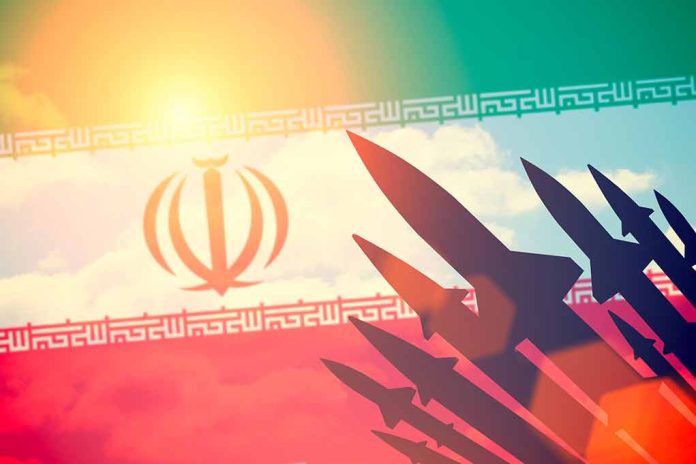
President Trump announces “very successful” strikes on three Iranian nuclear facilities as U.S. military drops “full payload of BOMBS” on fortified Fordow site, marking the first direct American intervention in the Iran-Israel conflict.
Key Takeaways
- U.S. military conducted strikes on three Iranian nuclear facilities: Fordow, Natanz, and Esfahan, with all American aircraft returning safely
- The operation utilized B-2 stealth bombers and the 30,000-pound GBU-57 “bunker-buster” bombs to penetrate Iran’s heavily fortified underground sites
- President Trump declared this an “HISTORIC MOMENT” and demanded Iran’s “UNCONDITIONAL SURRENDER,” escalating tensions after abandoning the Obama-era nuclear deal in 2018
- The strikes follow a week of Israeli attacks on Iran’s air defenses and missile capabilities, with Iran vowing retaliation against both nations
- This dramatic military escalation occurred after failed diplomatic efforts and represents a significant shift in U.S. Middle East strategy
America’s Decisive Military Action Against Iran’s Nuclear Program
In a dramatic escalation of Middle East tensions, the United States has launched strategic military strikes against three key Iranian nuclear facilities. President Trump confirmed the operation targeted Fordow, Natanz, and Esfahan – sites long suspected of being central to Iran’s uranium enrichment capabilities. The strikes represent the first direct American military involvement in the ongoing conflict between Iran and Israel, breaking with Trump’s previous promises to avoid further Middle East entanglements. According to officials, the heavily fortified Fordow facility, buried 300 feet beneath a mountain, received a “full payload of BOMBS” from American forces.
The military operation was conducted using B-2 stealth bombers that departed from Whiteman Air Force Base in Missouri with in-flight refueling support. These aircraft deployed the GBU-57 Massive Ordnance Penetrator (MOP), a specialized 30,000-pound “bunker-buster” bomb specifically designed to destroy deeply buried targets. U.S. and Israeli officials had concluded that only American stealth bombers equipped with these penetrating munitions could effectively neutralize Iran’s hardened underground nuclear infrastructure. President Trump’s decision came after intelligence assessments suggested Israel couldn’t accomplish the mission independently.
Trump’s Decisive Response After Failed Diplomacy
President Trump took to social media to announce the successful completion of the operation, declaring: “We have completed our very successful attack on the three Nuclear sites in Iran, including Fordow, Natanz, and Esfahan. All planes are now outside of Iran air space. A full payload of BOMBS was dropped on the primary site, Fordow. All planes are safely on their way home.” This dramatic military action follows Trump’s increasingly aggressive posture toward Iran after initially seeking a new nuclear agreement to replace the Obama-era deal he abandoned in 2018.
The military intervention came after a reported last-ditch diplomatic effort with Iran failed due to communication issues with Iran’s Supreme Leader Ayatollah Ali Khamenei. In the days leading up to the strikes, Trump had taken an increasingly confrontational stance, claiming U.S. control over Iranian airspace and directly threatening Khamenei by stating his location had been identified. Trump’s demand for Iran’s “UNCONDITIONAL SURRENDER” signals his administration’s determination to force compliance rather than negotiate, representing a significant shift from earlier approaches to the nuclear standoff.
Regional Implications and Potential for Retaliation
The U.S. strikes follow more than a week of Israeli military operations targeting Iran’s air defenses and missile capabilities. By joining the Israeli campaign against Iran’s nuclear program, the United States has significantly escalated the regional conflict and potentially drawn itself into a broader Middle East confrontation. Iranian officials had previously vowed to retaliate if the U.S. joined Israeli attacks, raising serious concerns about the safety of American troops and military installations throughout the region. This intervention comes despite Trump’s campaign promises to reduce American military involvement overseas.
“This is an HISTORIC MOMENT FOR THE UNITED STATES OF AMERICA, ISTAEL (sic), AND THE WORLD. IRAN MUST NOW AGREE TO END THIS WAR. THANK YOU!” stated President Trump.
President Trump scheduled a national address for 10 p.m. ET to explain the military action to the American public. The timing of the strikes – after preparations accelerated over the weekend with observable B-2 bomber movements toward Iran – suggests careful coordination with Israel, which was notified in advance. The targeting of Iran’s nuclear infrastructure appears calculated to demonstrate American resolve while supporting Israel’s security objectives. However, the operation raises serious questions about whether destroying these facilities will actually prevent Iran from reconstituting its nuclear program, potentially driving its activities further underground.
A High-Stakes Gamble with Uncertain Outcomes
The successful execution of strikes against Iran’s nuclear facilities represents a dramatic gamble in American foreign policy. While initially seeking diplomatic solutions, Trump and his national security team ultimately determined that negotiations had failed and military action was necessary. The strikes’ effectiveness in permanently degrading Iran’s nuclear capabilities remains uncertain, but the immediate demonstration of American military power is unmistakable. With Iran threatening retaliation, the coming days will be critical in determining whether this operation leads to further escalation or forces Iran to reconsider its position.
The strikes highlight the stark contrast between Trump’s decisive approach and the previous administration’s preference for multilateral diplomacy. By directly targeting Iran’s nuclear infrastructure, Trump has unequivocally demonstrated his willingness to use America’s military superiority to address threats to national security and support key allies. As the situation develops, the administration will need to carefully manage potential retaliatory actions while working to leverage this show of force into diplomatic advantages – a challenging balance that will test America’s strategic patience and military preparedness in a volatile region.







